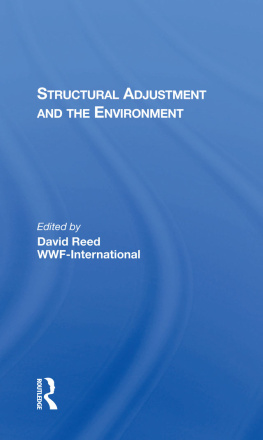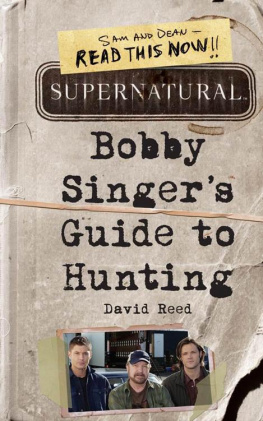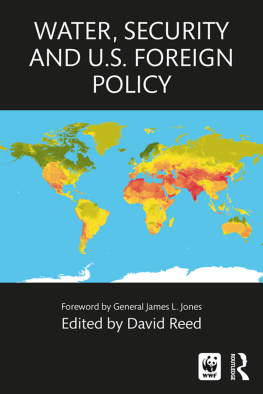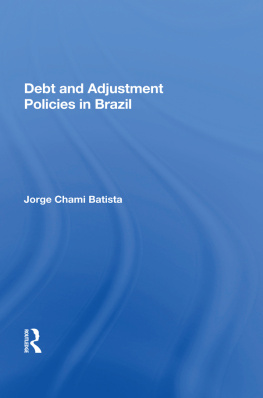First published 1992 by Westview Press, Inc.
Published 2019 by Routledge
52 Vanderbilt Avenue, New York, NY 10017
2 Park Square, Milton Park, Abingdon, Oxon OX14 4RN
Routledge is an imprint of the Taylor & Francis Group, an informa business
Copyright 1992 by World Wide Fund for Nature-International
All rights reserved. No part of this book may be reprinted or reproduced or utilised in any form or by any electronic, mechanical, or other means, now known or hereafter invented, including photocopying and recording, or in any information storage or retrieval system, without permission in writing from the publishers.
Notice:
Product or corporate names may be trademarks or registered trademarks, and are used only for identification and explanation without intent to infringe.
A CIP catalog record for this book is available from the Library of Congress.
ISBN 13: 978-0-367-28900-3 (hbk)
A publication having a provocative avocation, as does this book, is possible only with the support and sharp minds of many dedicated professionals. Contributions from colleagues on five continents enabled this research endeavor to mature from an urgent although poorly formulated idea some three years ago to a serious study of the environmental impacts of policy-based lending. It is nothing short of a privilege to have benefited from the dedication and support of so many gifted colleagues who helped steer this study through methodological, political, and logistical thickets of many kinds.
The core team of WWF colleagues, including Kevin Lynnette, Tony Long, Fulai Sheng, and Barry Coates, guided this project from its inception through many controversies to completion. Their innumerable hours spent reviewing texts, discussing conclusions, and sharpening recommendations effected a coherence that reflects the mission of WWF.
The London Environmental Economics Centre (LEEC) team, composed of Anil Markandya, Julie Richardson, and Joshua Bishop, translated the study's objectives into workable methodological approaches adapted to conditions of the three countries, Under Dr. Markandya's guidance, LEEC provided continuous technical and analytical support to the three country research teams.
Local research teams in Cte d'Ivoire, Mexico, and Thailand faced difficult conditions and challenges in carrying out their respective studies. Dr. Joseph Yao, Director of the Centre Ivoirien de Recherches Economiques et Sociales (CIRES), directed a team composed of Kouadio Yao, Joseph Akomian, and Odile Angoran. Dr. Juan Carlos Belausteguigoitia organized and directed a team of researchers from the Instituto Tecnologico Autonomo de Mexico (ITAM), including Jos Carlos Fernandez, Olga Elena Perez, and Carlos Muoz Pia. Drs. Theodore Panayotou and Chalongphob Sussengkarn from the Thailand Development Research Institute (TDRI) carried out the research program in Thailand. To each of them, we extend our sincere appreciation.
Members of the projects advisory committee were economists and development experts from developing and industrialized societies representing the full spectrum of views on structural adjustment. We extend our gratitude for the many weeks they spent traveling from all over the world to attend planning and review seminars, for the advice and comments on drafts of the book, and for the conviction and eloquence with which they defended their respective views. The committee was composed of Charles Abugre (Agency for Cooperation and Research in Development), Marcos Arruda ( Polticas Alternativas Para o Cone Sul, Rio de Janeiro), Laurence Hausman (United States Agency for International Development), Manuel Montes (East-West Center), Stanley Please (London), Michel Potier (Organisation for Economic Co-operation and Development), John D. Shilling (the World Bank), and Konrad von Moltke (Dartmouth College), with supporting comments and contributions from Robin Broad (the American University), Bindu Lohani (Asian Development Bank),and Jeremy J. Warford (the World Bank). They were joined by Patrick Murphy, WWF-International, and Eleanor Richter-Lyonette in several of their deliberations. It is important to state that participation on the advisory committee in no way implies endorsement of the study's findings or recommendations.
Drafts of the book greatly benefited from the insights and critical comments offered by Robert Goodland and John D, Shilling, who bear no responsibility for the views expressed herein. Bill Rau made several important contributions regarding development issues and the impact of structural adjustment. Christopher Herman offered numerous helpful suggestions on the recommendations. David Runnalls provided advice and written contributions on a range of environmental issues. The Institute of Social Studies Advisory Services, under the direction of Anthony Dolman, made important contributions on issues of political economy and provided helpful reviews at several stages of the project. Thanks to Stephen Kelleher (AMEX) for his comments on the Cte d'Ivoire case study.
Monica Chacon, WWF-International, provided invaluable assistance in managing the project on a day-to-day basis over for the better part of two years and in managing production. Allison Rogers, WWF-U.S., handled preparation of the text for the publisher. Many thanks to Sheila A. Mulvihill for her professionalism and patience in editing the book.
David Reed
Director, International Institutions Policy Program
World Wide Fund for Nature, WWF-International
The deed of foundation and statutes of World Wildlife Fund (WWF), registered in 1961, identify the first objective of the foundation as "world-wide conservation of the natural environment with particular emphasis on the maintenance of essential ecological processes and life support systems and on the preservation of genetic diversity and on ensuring that any utilization of species and ecosystems is sustainable." That same concern for conservation and sustainability was echoed in The World Conservation Strategy, issued jointly by WWF, the International Union for Conservation of Nature and Natural Resources (IUCN), and the United Nations Environment Programme (UNEP) in 1980. In keeping with the conservation practice of the time, however, a large part of the work funded or sponsored by WWF concerned the preservation of biodiversity and species per sc.
In 1989, the WWF family, which had already changed its name to World Wide Fund for Nature and had taken on a directly operational role in conservation programs, redefined its mission to focus on issues of most importance to conservation in todays circumstances. The mission
The conservation of nature and ecological processes by:
- Preserving genetic, species, and ecosystem diversity;
- Ensuring sustainable use of renewable natural resources now and in the longer term for the benefit of all life on Earth; and
- Promoting actions to reduce, to a minimum, pollution and the wasteful exploitation and consumption of resources and energy.
WWF's ultimate goal is to stop, and eventually reverse, the accelerating degradation of our natural environment and to help build a future in which humans live in harmony with nature.
This refocusing emphasizes the urgency of establishing a balance between the human species and nature or, in other terms, between the environment and development. Development requires the use of natural resources to our benefit. Conservation requires the sustainability of such use.






